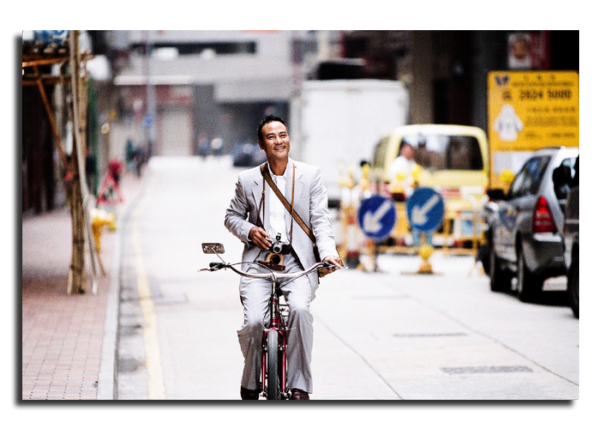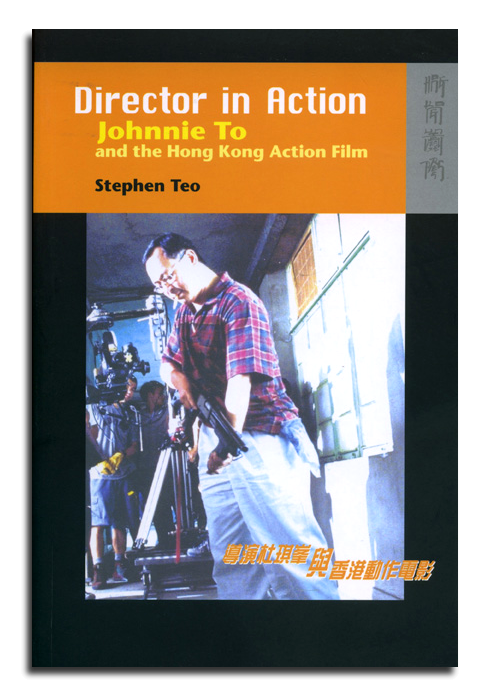 |
Statistics :
11630 Movies
19215 People
1448 Studios
29 Articles
73 Interviews
12 DVD Reviews
32452 Screenshots
3722 Videos
|
|
 |
 |
Critical darling |
4/4 - Page 11 |
 |
 |
 |
 |
 |
|

|
| Compared to the other interested parties, the academic community was a johnny-come-lately to the party. The fanboys had embraced To’s films beginning with 1993’s Heroic Trio and then early Milkyway Image movies such as A Hero Never Dies right through to recent works like Exiled. The critics and festival programmers discovered To in the early 2000s, beginning with The Mission, and have been particularly engaged with his more personal recent films such as Election 1 & 2, Mad Detective and Sparrow. The academics, on the other hand, took a much longer time to draw Johnnie To and his films into their discussion.
The academy first showed an interest in the films of Johnnie To around 2005. Earlier academic interest in the cinema of Hong Kong had focused on narratives of Chineseness, the diaspora, or transnational or global identity. Because To’s work doesn’t seem to be part of any school, trend or movement, or of direct significance to such debates, it was largely ignored. Likewise, To was not involved in any cinematic discourse on postcolonial, post-handover identity politics that so preoccupied intellectuals in the lead-up to the 1997 handover of Hong Kong to China. To’s films also don’t easily fit the requirements of auteur theory because of his varied, some might say uneven output. Furthermore, discussions focusing on genre cinema in Hong Kong have a tendency not to feel entirely comfortable with To because his most personal films belong and yet at the same time don’t quite belong to firmly defined film genres.

The Sparrow, © Milkyway Image (HK) Ltd., Universe Entertainment.
The earliest attempt by an academic and/or critic to discuss To within a critical theoretical framework is Andrew Grossman in his 2001 article for Sense of Cinema, “The Belated Auterism of Johnnie To” (1) Grossman has a hard time fitting To’s oeuvre into the framework of either auteur theory or genre theory. To’s body of work is characterized as too multifaceted and chameleonic to display any particular guiding formal or thematic principle, so he is categorized as a director of genre films. But then the Milkyway Image films of Johnnie To are described as deconstructionist, a burlesque spoofing of genre conventions that To had practiced throughout his career. It is significant that the two most common ways of viewing To and his filmmaking—the work of an auteur, or, conversely, the work of a technically impeccable director firmly entrenched in genre filmmaking—are laid out and applied to To and his films at such an early date. These two incongruent views of To will continue to play an important part in all subsequent discussions of To by members of the academic community. For example David Bordwell, who is generally quite savvy about Hong Kong cinema, in his brief 2003 Art Forum article reaches the rather limited conclusion that To’s chief accomplishment has been to create a more sophisticated and complex type of urban crime film (2). Again, the discussion is firmly situated in an examination of To as a maker of genre film.
|
| |

The Belated Auteurism of Johnnie To by Andrew Grossman
|
| |
| The first extended treatment of To and his films is a 2005 essay by Laikwan Pang (3). Pang has given herself the unenviable task of trying to discern a pattern to To’s Milkyway Image films from 1997 through 2004. Critical for her is the division of To’s Milkyway Image oeuvre into two phases: 1997-99, the gangster genre films, and 2000-04, the female-oriented light romantic comedies. She goes so far as to characterize Needing You as a turning point in Hong Kong film history, with a return to films dominated by female protagonists and aimed at female audiences: something not seen since the 1960s. The writer’s conclusion demonstrates just how risky it is to posit sweeping theories in relation to contemporary commercial filmmaking. Pang did not recognize the major dividing line that Infernal Affairs and to a lesser extent To’s own PTU represented in the subsequent history of Hong Kong cinema. For this reason, her arguments have already lost most of their currency less than five years after they were published. |
| |

Stephen Teo’s Director in Action: Johnnie To
|
| |
The first monograph dedicated to To, Stephen Teo’s Director in Action: Johnnie To and the Hong Kong Action Film, appeared at the relatively late date of 2007, after the apotheosis of To at the major European international film festivals (4). Stephen Teo is one of the most knowledgeable and respected writers on Hong Kong cinema and his monograph on To, the outgrowth of a doctoral dissertation, was widely anticipated in film studies and cinephile circles. It is a dense, theory-driven work betraying its origins as a doctoral dissertation. The academic theories Teo espouses in this work by and large dictate how he views To’s films, especially the films To directed or co-directed since the establishment of Milkyway Image. Despite all of the theoretical trappings, Teo reduces his discussion of To to two main themes: To as a genre director of action films and To as an “uneven auteur”. This is the same view of To Grossman had already articulated in his 2001 Senses of Cinema article. Teo’s rather reductive view of To disappoints by failing to offer either penetrating insights into To as a filmmaker or a more profound understanding of his films, both of which had been anticipated with the publication of this book.
In 2009 two critical studies of To appeared, each authored by a professor attached to a Hong Kong university. Enough time had passed since the watershed year of 1997 and its immediate aftermath to discern new patterns in Hong Kong filmmaking, patterns that the films of Johnnie To are interpreted as embodying. Vivian P.Y. Lee published a monograph, Hong Kong Cinema Since 1997: The Post-Nostalgic Imagination, that examines Hong Kong cinema since the handover of Hong Kong to China (5). She applies the theory of post-nostalgic imagination to Hong Kong cinema in this critical decade since 1997. Her emphasis is on the local visual culture, in this case Hong Kong films. She regards the cinematic image as providing connections to the larger sociopolitical realities of Hong Kong.
Lee provides a brief historical background of Hong Kong cinema before the handover. She then discusses the “post-nostalgic,” which she views as a serious attempt to regain a sense of history by a self-conscious grounding in the local popular cultural tradition, especially that of filmmaking. She highlights Johnnie To and his films since 1997 as a key figure in the transformation of the action genre, and recognizes his role in bringing that genre to international audiences. She also describes To as an “internationalized Hong Kong auteur.” (6) Lee devotes three chapters of the book, 72 pages out of 217, to a study of Hong Kong action cinema and its changing aesthetic. One 30-page chapter is devoted to Johnnie To. Four films carry the weight of her argument in this chapter: The Mission, Exiled, PTU and Mad Detective. Lee situates these films within the action genre and relates them to the heroic prototypes established in the films of John Woo, and developed since the mid-1980s. In the films of Johnnie To, Lee recognizes a move away from action-as-spectacle to action as part of an unfolding psychological drama. Lee credits To with successfully creating a new cinematic vocabulary that synthesizes old and new forms.
Quite different from Lee’s general survey of Hong Kong cinema since the handover is Michael Ingham’s study of a single To film, PTU, published as part of the New Hong Kong Cinema Series (7). In a lengthy first chapter Ingham looks at To’s career as a filmmaker and lays out his place within Hong Kong cinema since the 1980s. Ingham is of the opinion that Johnnie To should not be described as an action director. He questions the use of the term “action film” as a specific critically and professionally acknowledged genre, noting its origin as a video store label. Instead of the “action” genre, Ingham places many of Johnnie To’s most accomplished solo directorial efforts since the founding of Milkyway Image into the category of the policier or crime genre. In contrast to Lee, who looks to To’s films for evidence of the “post-nostalgic” imagination, Ingham views To’s films as part of a discourse on violence and power, on professionalism and ethical responsibility in Hong Kong society. He sees this as characteristic of the post-1997 discourse that is shared by films like the Infernal Affairs trilogy, but is not found in the pre-1997 anxiety films. As with Lee, Ingham also connects To’s output to the “heroic bloodshed” tradition that originated with John Woo and Ringo Lam. Specifically, Ingham looks at how To deconstructs the genre and character types of this filmic tradition.
Taking up the question of whether or not Johnnie To is an “auteur,” Ingham characterizes To’s cinema as distinctly Hong Kong rather than transnational. He feels that To’s roots are as much in the Asian cinema of Hong Kong’s genre films as in great foreign directors. Looking at the auteur question in relationship to Johnnie To, Ingham notes that few Hong Kong filmmakers thought of or think of themselves as “auteurs.” Ingham notes that To shies away from using the term in discussing his own work and it is not a category that Ingham finds particularly useful or descriptive in his discussion of To.
Academic discussions focusing on the work of Johnnie To since the founding of Milkyway Image in 1997 restrict themselves to viewing To from two not wholly compatible perspectives: To as director of genre films that are the heirs of the local heroic bloodshed tradition as established by John Woo, or To as a highly idiosyncratic auteur whose output does not neatly fit within any accepted definition of auteur filmmaking.
Both views of To and his works have a tendency to be reductive and, to be true to their tenants, must leave out a large number of To’s films since 2000. Such restrictive theories, which marginalize or simply ignore half or more of To’s work, call into question the appropriateness of either theory as a comprehensive framework for analyzing this filmmaker and his entire output. Compounding the difficulty is To’s continued evolution as an active and highly prolific filmmaker. Furthermore, the theories proposed to date also do not fully acknowledge the tension in To’s lengthy career between art and commerce, a tension that exerts its considerable pull on every film To has produced, co-directed or directed. This tension, as much as anything else, has had a major hand in shaping Johnnie To as a filmmaker, a tension which he has amply acknowledged and discussed in interviews over the years. While it is an acknowledgement of sorts that the films of Johnnie To have recently been drawn into academic discussions of Hong Kong cinema, the increased scrutiny has yet to yield significant insights into Johnnie To and his importance as a filmmaker within Hong Kong, his importance as a Hong Kong filmmaker on the international stage, or his future legacy. Perhaps it is still premature to write the final word on a filmmaker who is at the peak of his creative powers and continues to make films at a rate that would be considered exceptional almost anywhere but Hong Kong. Given the inconclusive and fragmentary picture that has emerged from 10 years of examining To’s movies in the context of genre filmmaking and/or auteur theory, perhaps the time has come to move on and to take a fresh look at his work and attempt to discern different patterns, ones more suggestive of fruitful avenues for future inquiry. |
 |
| notes |
(1) Andrew Grossman, “The Belated Auteurism of Johnnie To,” Senses of Cinema,
(2) David Bordwell, “The Films of Johnnie To: Louder Than Words—Critical Essay—Biography,” Art Forum, May 2003,
(3) Laikwan Pang, “Post-1997 Hong Kong masculinities,” Laikwan Pang and Day Wong, eds., Masculinities and Hong Kong Cinema, (Hong Kong: Hong Kong University Press, 2005), 35-55.
(4) Stephen Teo, Director in Action: Johnnie To and the Hong Kong Action Film (Hong Kong: Hong Kong University Press, 2007).
(5) Vivian P.Y. Lee, Hong Kong Cinema Since 1997: The Post-Nostalgic Imagination (Houndsmills: Palgrave Macmillan, 2009).
(6) Lee, Hong Kong Cinema Since 1997, 87-88.
(7) Michael Ingham, Johnnie To-Kei-fung’s PTU (Hong Kong: Hong University Press,
|
|
|
| |
 |
|
|
Page :
1
2
3
4
5
6
7
8
9
10
11
12
13
14
15
16
17
18
19
20
Top
|
|
|
|
|
|
|
 |
